
The Voluntary Aid Detachment (VAD) was a voluntary organisation, providing field nursing services, mainly in hospitals to Britain and various other countries in the British Empire. The organisation was founded in 1909, with the help of the Red Cross and Order of St John.
By the summer of 1914 there were over 2,500 Voluntary Aid Detachments in Britain. Each individual volunteer was called a ‘Detachment’, or simply a VAD. Of the 90,000 VAD’s who served in World War One, two-thirds were women and girls, mainly from well educated and ‘middle class’ backgrounds. They assisted with cooking, clerical tasks and nursing. They aided the sick and injured from the battlefields in very dangerous circumstances. Diseases such as cholera, typhoid and the Spanish flu struck the troops and affected many of the VAD’s. At least 500 nurses died in World War One, many of ‘Flu’ serving their patients to the end. The true casualty figure for nurses may never be known due to inconsistencies in the recording process. However, a memorial to those nurses who died, including over 100 VAD’s, was erected at York Minster after the war. The devotion and dedication of the VAD’s was a remarkable legacy of the First World War.
In Hull, Lady Marjorie Wynn-Carrington, also known as Lady Nunburnholme, contributed immensely to Hull’s Voluntary Aid Detachments in World War One.
Lady Nunburnholme, became President of the organisation, and made 150 Peel Street, the Headquarters for the ‘Voluntary Aid Detachments of Hull and East Riding’. She organized three hospitals to be started in Hull. She also opened the popular ‘Rest Station’ canteen, at Hull Paragon Railway station, on the 1st September 1914. Towards the end of 1916, she successfully raised money for a Christmas Fund and sent gifts to troops associated with Hull and East Riding. The Fund was popular and on one day alone collected over £1,000. In November 1917 the Christmas Fund raised over £3,000, sending gifts to thousands of men overseas. Observers on the Western Front noted how well the East Yorkshire soldiers were looked after by their Home town of Hull.
Support Services
Hull established a number of complimentary Charities during the war. These included the Hull and East Riding Fund, for the needs of local units and prisoners of war (headquarters at Peel House, Peel Street, Hull); Hull Social Club for Soldier’s and Sailor Wives, Mason Street, Hull; The Lord Mayor’s Local War Relief Fund; Hull District War Refugees (Belgian refugees); Interned Hull Seaman’s War Charities (to provide necessities and comforts for merchant seaman, interned in enemy territory); Hull Patriotic Fund for widows of soldiers and sailors, and the Hull Great War Civic Trust in 1918, to help Hull’s wounded and their Dependents; Hull Bread Fund to supply English Prisoners of War: The Hull & Barnsley War District Relief Fund, to assist dependents of their railway staff serving.

 ‘
‘
Soldiers Clubs’ were raised in Hull to help serving men. A Soldiers Club with reading room was located at Beverley Road baths on Stepney Lane and run by Major A J Atkinson and his wife.
A ‘Soldiers & Sailors Wives Club’ was formed on Mason Street by Mrs Hubert Johnson, the wife of the Lord Mayor. It was devoted to provide relaxation for the wife’s of servicemen away from home.

Paragon Railway Station housed a popular ‘Rest Station and canteen’ well used by departing troops. It was established by Lady Nunburnholme, on the 1st September 1914 and was staffed throughout the war by Voluntary Aid Detachments (VAD’s). This provided refreshments as well as ‘First Aid’
‘Peel House’ at 150 Spring Bank, was the VAD headquarters, and run by the Lady Mayor.  Peel House helped train nurses and locate hospital accommodation for soldiers posted to Hull. It also sent out thousands of parcels of clothing and essentials to troops home and abroad. War Correspondents in France were struck by the way East Yorkshire Units were looked after by people back home. Its most renowned work was sending thousands of food and clothing parcels, plus other necessities to Prisoners of War. This work was extended to captured seaman and interned civilians. Peel House raised public funds to fund their work. The residents of Freehold Street created a ‘POW Bread Fund’ and distributed food to prisoners of war through Peel House.
Peel House helped train nurses and locate hospital accommodation for soldiers posted to Hull. It also sent out thousands of parcels of clothing and essentials to troops home and abroad. War Correspondents in France were struck by the way East Yorkshire Units were looked after by people back home. Its most renowned work was sending thousands of food and clothing parcels, plus other necessities to Prisoners of War. This work was extended to captured seaman and interned civilians. Peel House raised public funds to fund their work. The residents of Freehold Street created a ‘POW Bread Fund’ and distributed food to prisoners of war through Peel House.
Hull was known as the ‘Doorstep to Blighty’ and received some 80,000 repatriated Prisoners of War, through its ports.
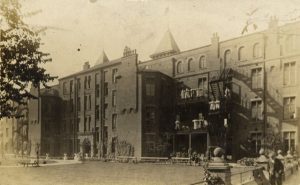
The hospital started accepting casualties almost immediately and between August 1914 and January 1917, almost 2,500 patients, mainly soldiers and military personnel, were treated in Hull. By January 31, 1917, Britain’s naval base hospitals were under intense pressure because of the number of casualties from the war at sea so the Admiralty asked that the hospital should only accept naval casualties.
Six large and six smaller wards were used to treat 204 men and 16 officers. A matron and 12 trained sisters ran the wards with the nurses coming from the Kingston and Western Division of the St John Ambulance Association Voluntary Aid Detachment. By the time the hospital closed in January 1919 following the end of the war, it had treated a further 4,000 patients.
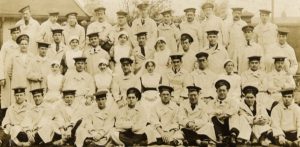
Hull handed over the infirmary to the War Office at York on August 15 with the Dowager Lady Nunburnholme offering to pay for the building to be equipped with stores and provisions.
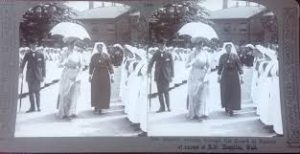
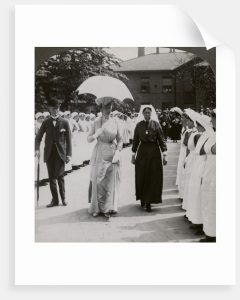
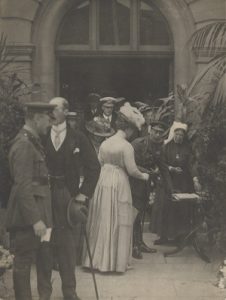
Sister Mary Michael was based at the Beverley Road Convent, Hull (The Endsleigh Centre). She was born as Mary McLaughlin in 1866 and entered the convent on Anlaby road 1885 with her first profession been made in march 1889.
During the First World War 1914 to 1919, the nuns visited many soldiers that had been injured and sent back from France to hospitals in Hull. One such Hospital was Brooklands Military Hospital, on Cottingham Road (now the Dennison centre opposite Hull university). One of the soldiers she was to meet was the writer and poet, J.R.R. Tolkien, who had been sent back from Fance with trench fever in 1917.

She became friends with Tolkien and later became godmother to his 2nd son. She stayed in touch with Tolkien all her life as evidenced by a letter written in 1949 when he describes her has a dear old friend. By this time she was to celebrate her diamond jubilee as 60 years, a nun. She later moved to a resident home in Whitby and died in 1951.
John Ronald Reuel Tolkien, great works are said to have been inspired by his stayat Brookland Hospital in Hull.
For Eighteen months in 1917 and 1918, author of The Hobbit, Lord of the Rings and many other fantasy and children’s books, J.R.R. Tolkien lived at Brookland’s Military Hospital on Cottingham Road in Hull. He had seen his battalion, which was fighting in the first world war, disbanded because of the huge number of casualties it suffered and was sent to East Yorkshire to recuperate from trench fever. It’s now generally accepted that the landscape and coastline of East Yorkshire informed Tolkien’s later writing. It has been dubbed ‘The Tolkien Triangle’.
He spent time at Kilnsea and Easington and learned about the villages which were lost to the sea due to coastal erosion. It’s also believed that a wood near Roos, which he visited with his wife, was the inspiration for the one he created near the fictional Hobbiton. Tolkien even directly copied some East Yorkshire place names into his work, with the village of Wetwang, for example, appearing in the Fellowship of the Ring.
To commemorate the time Tolkein spent in East Yorkshire, a plaque was mounted on the former Brookland’s Hospital , which is now called the Dennison Centre and is part of the University of Hull’s campus.
Photos above, from the Imperial War Museum Collection, and “Hull, the Good Old Days” Facebook.
